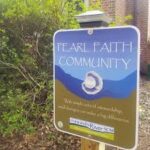Below is the text of a letter sent by The Elizabeth River Project to City of Norfolk Government Manager Patrick Roberts:
The Elizabeth River Project strongly supports maximizing long-term conservation of greenspace and meaningful public access to the Elizabeth River by the creation of a public park at the former Lamberts Point golf course.
No other site in Norfolk presents as great an opportunity for increasing public access and preserving green space on the Elizabeth River. The City of Norfolk’s 15 acres at this site represent a rare amount of available greenspace in our densely developed urban city. The high knolls present panoramic views of Norfolk’s iconic harbor not to be found anywhere else.
Multiple studies demonstrate that public parks increase quality of life and improve mental health and wellness for residents while reducing crime, increasing nearby property values and conserving clean water and wildlife habitat. These benefits would be especially meaningful for the adjacent, historically marginalized community of Lamberts Point. As well, the potential to link to Norfolk’s extremely popular and well-used Elizabeth River Trail also offers terrific opportunities to increase Norfolk’s attractiveness to younger generations.
While we strongly support maximizing the conservation of green space and public access at this site, we also recognize the diverse interests in this location of multiple community partners including Old Dominion University, party to a relevant agreement. It may be useful for the City of Norfolk to engage in a
facilitated discussion with HRSD, Old Dominion University and the Elizabeth River Trail Foundation, as well as representatives of key community groups, to determine how diverse interests might be taken into account for a win-win approach, with consideration of whether it may be useful to shift property boundaries in any way. We stand ready to assist as may be helpful.
Regarding the multiple benefits that could accrue from this becoming public green space:
According to studies by the Centers for Disease Control and Prevention, creating, improving and promoting places to be physically active can improve individual and community health and result in a 25 percent increase of residents who exercise at least three times per week.
- A study by Penn State University showed significant correlations to reductions in stress, lowered blood pressure, and perceived physical health to the length of stay in visits to parks.
- Access to parks and recreation opportunities has been strongly linked to reductions in crime and to reduced juvenile delinquency (National Recreation and Park Association).
- Parks improve the local tax base and increase property values. A Texas A&M review investigating whether parks and open space contributed positively to the property values of surrounding properties found that 20 of the 25 studies found that property values were higher.
For this urban ecosystem, 15 acres of green space is invaluable. The Trust for Public Land has found that for every public $1 invested in land conservation, $4 in natural goods and services is returned to the Commonwealth of Virginia (www.tpl.org/va-roi-report 2016). This includes reducing stormwater runoff, improving removal of air pollution, carbon sequestration and providing wildlife habitat.
For all these reasons, the Elizabeth River Project again urges maximizing the preservation of greenspace and public access at this unusually compelling waterfront site.

